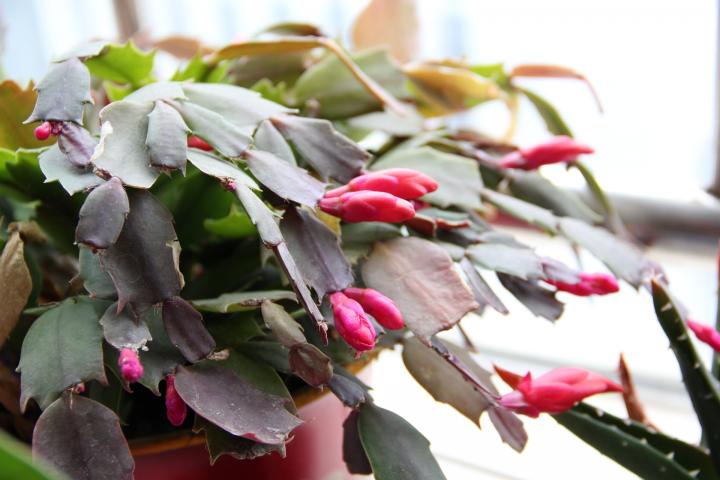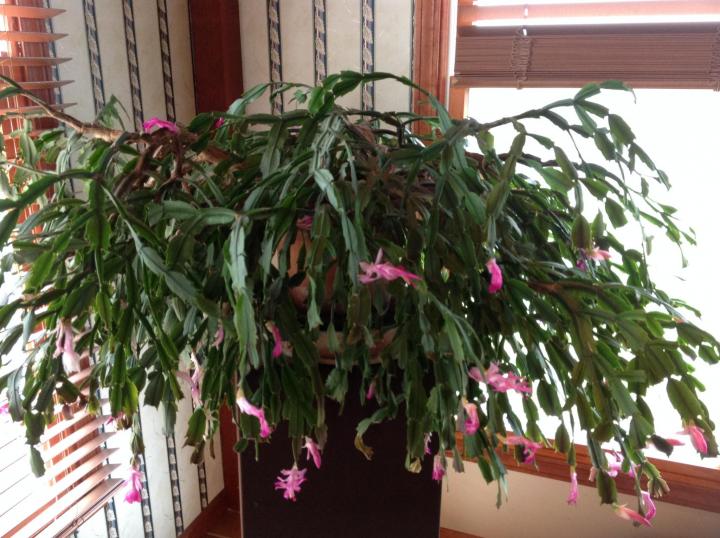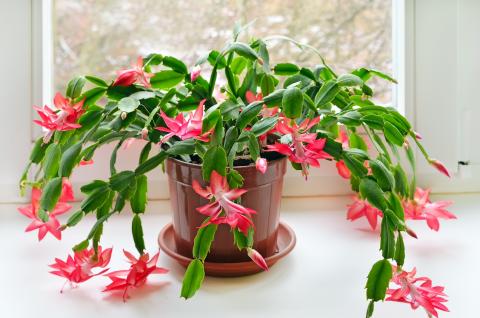The Christmas cactus is a very popular houseplant—and for good reason! When they bloom, they produce colorful, tubular flowers in pink or lilac colors. Their beautiful flowers, long bloom time, and easy care requirements make them a wonderful plant. We’ll bet someone in your family has a Christmas cactus!
About Christmas Cacti
Unlike other cacti, the Christmas cactus (Schlumbergera x buckleyi) and its relatives don’t live in hot, arid environments such as deserts or plains. In fact, these epiphytic succulents are native to the tropical rainforests of southern Brazil, where they grow on tree branches and soak up the high humidity, dappled sunlight, and warm temperatures.
The bottom line: Don’t treat a Christmas cactus like it’s a run-of-the-mill cactus or succulent. They can’t take the same sort of sunny, dry conditions that other cacti can. It’s important to water these cacti more regularly than most succulents, but to also be cautious of keeping them too wet. (See detailed care instructions below.)
Thanksgiving, Easter, or Christmas Cactus?
There are three main types of “holiday” cacti out there: the Easter cactus (S. gaertneri), Thanksgiving cactus (S. truncata), and Christmas cactus (S. x buckleyi). Each holiday cactus typically blooms closest to the holiday that it’s named after. However, most of the “Christmas cacti” sold today are actually Thanksgiving cacti, which tend to bloom from November through February and therefore pass unnoticed as Christmas cacti. To learn more, see our article on the different types of holiday cacti and how to tell them apart.
Note: For simplicity’s sake, we refer to all three of these species as “Christmas cactus” on this page, since this is the most commonly used term and our care advice applies to all of them!
Potting Christmas Cacti
- When selecting a pot for a Christmas cactus, be sure to choose one that has a drainage hole in the bottom. This helps to keep the soil from getting too wet.
- Christmas cacti grow well in most potting mixes that are formulated for succulents. The important thing is that your potting soil drains well.
Where to Put a Christmas Cactus
- Plants should be kept in bright, indirect light. An east-facing window or a bright bathroom is ideal. Too much direct sunlight can bleach the sensitive leaves.
- A daytime temperature of 70°F (21°C) and an evening temperature of 60-65°F (15-18°C) is preferred.
- Christmas cacti prefer a more humid environment, which makes a bright bathroom or kitchen a good spot to keep them.
- In the summer, Christmas cacti can be placed in a shady spot in the garden or in an unheated porch until temperatures get below 50°F (10°C). Keep them out of direct outdoor sunlight.
How to Care for Christmas Cacti
- Plan to water every 2-3 weeks, but only water when the top one third of soil feels dry to the touch. For example, if the plant is in 6 inches of soil, water when the top 2 inches feel dry. (Use your finger to check!)
- When the soil is sufficiently dry, soak the soil until water runs through the pot’s drainage holes. Place a tray underneath the pot to catch the water. After 10-15 minutes, discard any excess water in the tray so that the pot doesn’t sit in water.
- It’s especially important to water well while the plant is flowering.
- From spring through early fall, feed every 2 weeks with a balanced houseplant fertilizer. During the fall and winter, feed the cactus monthly to encourage successful blooming.
- Prune plants in late spring to encourage branching and more flowers. Simply cut off a few sections of each stem; the plant will branch from the wound.
- If you wish, place the cut pieces in a lightly moist potting soil—they root easily after a few weeks and make for excellent Christmas presents!

How to Get Your Christmas Cactus to Bloom
The blooms of Christmas cacti and its relatives are triggered by the cooler temperatures and longer nights of fall. The three main types of holiday cacti generally bloom according to this schedule:
- Thanksgiving cacti are the earliest and longest bloomers, typically producing flowers from late fall through mid-winter.
- Christmas cacti tend to bloom from early winter to mid-winter.
- Easter cacti bloom from late winter to mid-spring.
If your cactus is not blooming, it may be receiving too much light or too-high temperatures. Here are some tips to encourage yours to produce flowers!
- To trigger blooming, nights need to be at least 14 hours long and days between 8 to 10 hours for at least six weeks. If you have strong indoor lighting that’s on at night, you may need to cover your cactus or move it to an area that’s exposed to the natural light cycle.
- Flower buds form best when the plant is kept in temperatures between 50 and 60°F (10 and 15°C).
- You can kickstart the budding process by exposing the plant to temperatures of about 45°F (7°C) for several nights in a row.
- Make sure that you are consistent with watering while the plant is in flower. If the plant dries out too much, it may drop its buds.
- If the cactus sheds its buds one winter, don’t worry: it should bloom the following year!
Blossom drop: If your Christmas cactus is exposed to any type of stress, the plant will likely drop its blossoms. This could be related to the amount of light, or a sudden change in temperature, as discussed in above plant care section. Also, ensure that your soil doesn’t get too dry while buds are forming.
The plant may be susceptible to mealy bugs and, if over-watered, root rot. If you have problems, cut out infected areas and repot in clean soil.
There are three main types of “holiday cacti” available:
- Thanksgiving cacti (Schlumbergera truncata) bloom from late fall to mid-winter and are often mislabeled as Christmas cacti.
- Christmas cacti (S. x buckleyi) bloom from early winter to mid-winter.
- Easter cacti (S. gaertneri) bloom from later winter to mid-spring.

- When the buds of a Christmas cactus look as if they’re about to open, make sure you water the plant regularly and keep it cool.
- Late spring is the best time to propagate cuttings because most holiday cacti emerge from their winter rest and initiate new growth.




